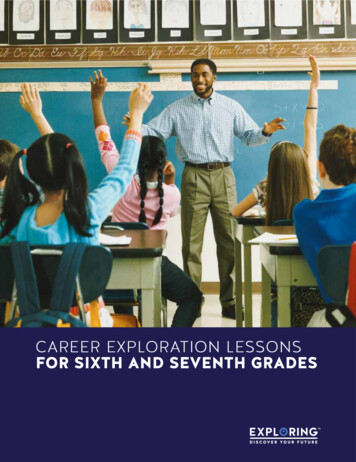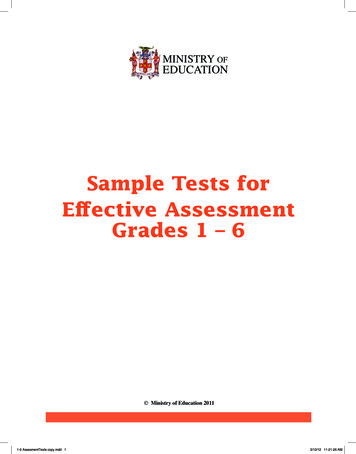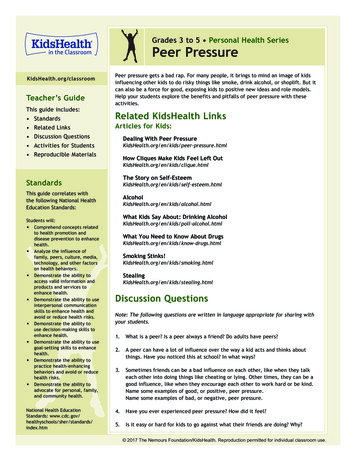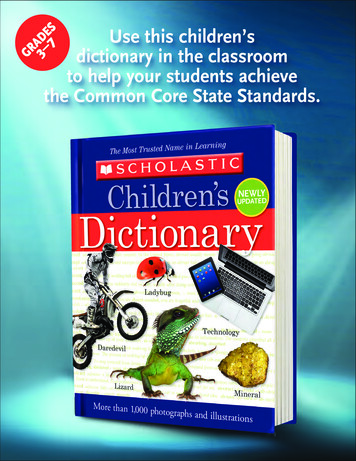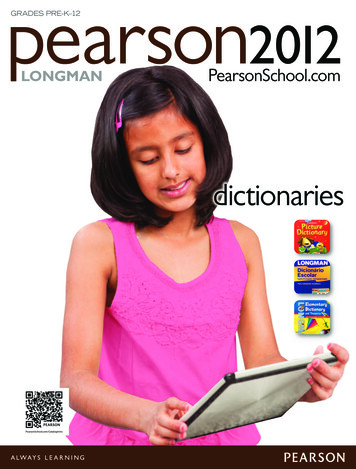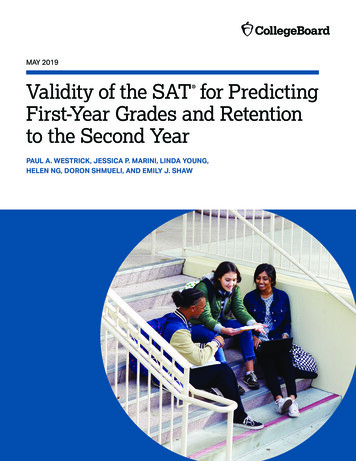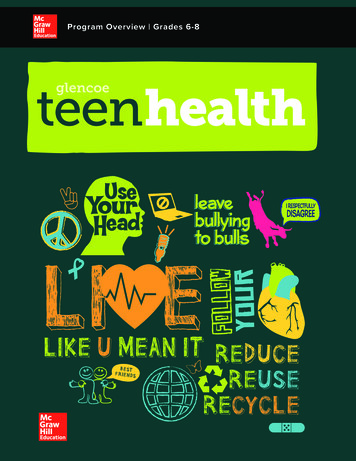
Transcription
Program Overview Grades 6-8teenhealthglencoeB E STF R IE N D SREDUCEREUSERECYCLE
the comprehensive solution formiddle school healthcontentsTable of Contents . 3Flexible Format . 4Teen Health is a comprehensive program that engages middleschool students in an exploration of health and wellness. Studentsapply real-world health skills as they create individualized plans forhealthy lives. This flexible program can be delivered online throughConnectED, in a traditional print format, or a combination of both.The hybrid approach to teaching middle school health allows you toselect the topics relevant to your students and provide them print oronline content at home or in the classroom.This program: Uses content built on the 10 health skills developed from theNational Health Education Standards to ensure an all-inclusivehealth course. Engages students in active learning that enables them topractice the health skills. Provides Fitness and Nutrition activities that show students howto lead an active and healthy lifestyle. Enables you to customize your entire program and how youteach it - from the delivery method to the content. Provides many online features that keep the program currentfor you and your students.2Student Text . 6Assessments . 7Fitness . 8Foldables . 10Hands-On Health . 11
teen healthtable of contentsUNIT 1:UNIT 7:BUILDING HEALTHY RELATIONSHIPSBODY SYSTEMSChapter 1 Building Healthy RelationshipsChapter 13 Body SystemsChapter 2 Dating Relationships and AbstinenceUNIT 8:UNIT 2:TOBACCO, ALCOHOL, AND OTHER DRUGSBUILDING CHARACTERAND PREVENTING BULLYINGChapter 14 TobaccoChapter 3 Building CharacterChapter 16 DrugsChapter 4 Bullying and CyberbullyingUNIT 3:MENTAL AND EMOTIONAL HEALTHChapter 5 Your Mental and Emotional HealthChapter 6 Mental and Emotional DisordersUNIT 4:CONFLICT RESOLUTIONAND VIOLENCE PREVENTIONChapter 7 Conflict ResolutionChapter 15 AlcoholChapter 17 Using Medicines WiselyUNIT 9:SAFETY AND ENVIRONMENTAL HEALTHChapter 18 Communicable DiseasesChapter 19 Noncommunicable DiseasesUNIT 10:SAFETY AND A HEALTHY ENVIRONMENTChapter 20 SafetyChapter 8 Violence PreventionChapter 21 Green Schools andEnvironmental HealthUNIT 5:HEALTHY RELATIONSHIPS AND SEXUALITYNUTRITION AND PHYSICAL ACTIVITYChapter 9 NutritionChapter 10 Physical ActivityUNIT 6:(Optional module)Chapter 1 The Teen YearsChapter 2 The Reproductive SystemChapter 3 Sexual Feelings and RelationshipsHEALTH DURING THE LIFE CYCLEChapter 11 The Life CycleChapter 12 Personal Health Care3
flexibleformattraditional print materialsTeen Health is a flexible program available in a traditional print format, digital, or both! The hybridapproach to teaching health allows you to select the topics relevant to your students and providethem print or online content at home or in the eonline.comB ESTF R IEN DSREDUCEREUSERECYCLEThe traditional print format includes a durable, hardbound student edition with the optionalHealthy Relationships and Sexuality softcover module. A hardbound teacher edition is alsoavailable with this program.4
digital subscriptionsStudent and teacher subscriptions available through ConnectED provideaccess to the full Teen Health program – plus additional online features.Student Center· Online Student Edition (interactive)· Spanish Student Edition· Interactive worksheets· Online student-teacher messaging· Online assessment· Web Quest activities· Foldables · Bilingual Glossary· Podcast activities· Online review, quizzes, and chapter tests· Flip 4 Fitness activities· In The News section· Ongoing updates for statistics, charts, and graphs· Resource Library· Creative Web links for studentsTeacher Center· Annotated Student Edition· Customizable lesson plans· Class and individual student assignmentmanagement and tracking· Online student-teacher messaging· eAssessment Test Generator· Resource library with over 4,500 accessible videos,documents, and images· Creative Web links for teachers· Correlations and national and state standards· Conference/grant links· Whiteboard activities· Inclusion strategies· Coded activities for all learning levels5
student textThe text guides students to immediately apply what is being taught and encouragesinteraction. In the Online Student Edition, students can highlight words or sentences as theyread, and take notes on the chapters in their personal Notebook.· Each lesson begins with aBig Idea that summarizesthe lesson content.· As You Read provides an activity forstudents to complete to organize theinformation presented in the lesson.· The Main Idea summarizes the contentwithin a small section of text.6· Before You Read at the start of each lesson willhelp students think about the topic and give theman opportunity to write in their journal.· The Bilingual Glossary containsvocabulary terms and definitions inSpanish and English
printand digital assessmentslesson reviewAt the end of each lesson, a lesson review allows students to reflect on the contentlearned. In the Online Student Edition, students can type directly into the response fieldsand save their answers.CHAPTER 4ASSESSMENTUsing complete sentences, answer the following questions on a sheet of paper.Thinking CriticallyReviewing Vocabulary and Main Ideas› bullying› intimidation› harassment› cyberbullying› labelingOn a sheet of paper, write the numbers 7-12. Write Trueor False for each statement below. If the statement isfalse, change the underlined word or phrase to make ittrue.LESSON 1 Bullying and Harassment1. Purposely frightening another person throughto hurt another person.describing how a zero tolerance policy might stopbullying.ICESTANDARDIZED TEST PRACTReadingRead the passage below and then answer9. Bullies are more likely to target a student who is with hisPromoting Safe Schools10. A policy that makes no exceptions for anybody for anyreason is called a zero tolerance policy.is also referred to as name-calling.11. Some bullying is wrong.12. Any teen who is bullied, or who has a friend who isLESSON 2 Cyberbullying6. Electronic posting of mean-spirited messages about athe questions that follow.A personBullying comes in many shapes and forms.with physicalmight call you names or threaten youtry to keepviolence. A person might tease you orattackyou from a group. Bullies may even physicallygiven teensyou. In recent years, technology has alsosend a nastya new way to bully others. They mightIn addimessage in an e-mail or through a website.aaboutmessagesltion, they might post disrespectfuperson or post embarrassing videos.the personIf you’re being bullied, try to ignoreevencalm,remaintoTrypossible.and walk away, ifleaving. Beif the bully tries to prevent you fromtry not to letforceful and stand up for yourself, butimportant tothe confrontation turn physical. It issuch asreport the incident to a person in authority,adult.a teacher, counselor, or other trustedor her friends.LESSON 45. Uninvited and unwelcome sexual conduct directed atperson, often done anonymously, is called16. EXPOSITORY WRITING Write a paragraphhears the bully call him “chicken.” What should Sethdo? Explain.is happening.criticizing his or her race, color, religion, physicaldisability, or gender is known as.another person is known asbullying incident. Describe the traits of the bully andthe form of bullying that occurred.14. EVALUATE When Seth walks away from a fight, he8. Using humor can be a strategy to stop bullying when itis a type of violence in which one personuses threats, taunts, or violence to intimidate anotheragain and again.3. Ongoing conduct that offends another person by4.15. NARRATIVE WRITING Write a fictional story about aLESSON 3 Strategies to Stop Bullying7. Bullying behavior is actions or words that are designedthreatening words, looks, or body language is called.2.part of the country. She speaks with an accent that isdifferent than that of the students in her new school.Kathy, a girl in her class, imitates Zoey’s accent,teasing her whenever she speaks. Kathy’s teasingreally bothers Zoey. What should Zoey do?› sexualharassmentOn a sheet of paper, write the numbers 1-6. Aftereach number, write the term from the list that bestcompletes each sentence.Write About It13. SYNTHESIZE Zoey recently moved from a differentbeing bullied, should tell a parent or teacher about thebullying.1. What does confrontation meanin this sentencefrom the passage?but try notBe forceful and stand up for yourself,to let the confrontation turn sion2. Which of the following best describespose of the second paragraph?the purothers.bullyA. To explain reasons why peoplemakes a perB. To describe how being bullyingson feelC. To suggest ways to deal with bullyingbe toleratedD. To give reasons bullies shouldeAssessment8080CHAPTERCCHHAPPTTERR 4 AsseAssessmentAsessmment0080 0081 NA S M02 C04 CA 138540.indd 80AssessmentAAsssesssmmenentt12/5/12 3:21 PM0080 0081 NA S M02 C04 CA 138540.indd 8188112/5/12 3:22 PMchapter assessmentsOnce all lessons are complete, a chapter assessment tests studentson the content learned in each lesson.7
flip 4 fitnessWith Teen Health, students have fun as they learn to be physically fit. The back of theprint book features the Flip 4 Fitness section. Flip 4 Fitness is a handbook that helpsstudents get started with physical activity, whether they are non-athletes who donot participate in organized sports, or athletes who need tips to cross train for theirfavorite sport. The handbook focuses on the five elements of fitness to help studentsset and reach their fitness goals. Flip 4 Fitness offers suggested activities and sports,and provides tips on how to make each activity safe, fun, and productive.Flip for Fitness is for everyone. Non-athletes whoavoid joining organized sports can develop a personalfitness plan to stay in shape. Even athletes can usesome of the tips to cross train for their favorite sport.Planning a RoutineFlip for Fitness helps you plan a fitness routinethat helps your body slowly adjust to activity.Over time, you will increase both the length oftime you spend and the number of times thatyou are physically active each week. Teens shouldaim to get at least one hour of physical activityeach day. These periods of physical activity canbe divided into shorter segments, such as three20 minute segments each day. Exercise includesany physical activity, such as completing a fitnessplan, playing individual or group sports, or evenhelping clean at home. The key is to keep yourbody moving.Alistair Berg/Digital Vision/Getty ImagesBefore You Start ExercisingEvery activity session should begin with a warmup to prepare your body for exercise. Warm-upsraise your body temperature and get yourmuscles ready for physical activity. Easy warm-upactivities include walking, marching, and jogging, as well as basic calisthenics or stretches. Asyou increase the time you spend doing a fitnessactivity, you should increase the time you spendwarming up. Check the Sample Physical FitnessPlan in Teen Health in Connect Ed.F FF4F 18
fitness zoneFitness Zone callouts throughout the text incorporate fitness into the content of thelesson. Fitness Zone Online is a multimedia resource that shows students how to bephysically active every day. This complete system of activity cards, videos, podcasts,and heart rate activities helps teachers to objectively assess students’ fitness levelsand develop customized individual fitness improvement plans.The Nutrition and Physical Activity Resources include: Clipboard Energizer Activities Fitness Zone Videos Polar Heart Rate Monitor Activities Podcasts Nutrition, physical activity, and injury prevention tips9
Lesson ReviewFoldables study organizers appear in the first lesson of each chapter. Foldablesare three-dimensional, interactive graphic organizers that allow students to quicklyorganize and display data. At the beginning of the lesson, students are asked tocreate a Foldable, and record information learned in the lesson. When preparing forthe chapter assessment, students are asked to use the Foldable they created to helpwith studying. All of the Foldables for Teen Health are located at the back of theprint book, as well as in the Resource Center in ConnectED.Chapter 1 Foldables Make this Foldable to help organize what you learn in Lesson 1.1Begin with a plain sheetof notebook paper. Foldthe sheet of paper inhalf along the long axis.3Unfold and cut thetop layer along bothfold lines. This makesthree tabs. Draw twooverlapping ovals.2Turn the paper, and fold itinto thirds.4Label the left tabVerbal, the middletab Communication,and the right tabNonverbal.Write the definitions and examples of verbal and nonverbal communicationunder the appropriate tab. Under the middle tab, describe how both types ofcommunication help to share feelings, thoughts, and information.Chapter 2 Foldables Make this Foldable to help organize what you learn in Lesson 1.1Begin with a plain sheetof notebook paper. Drawa straight line across themiddle of the page todivide it in half.4Cut along the creases youhave made in the top andbottom flaps.2Fold the top and bottomquarters of the pageto meet the line in themiddle.5On the four flaps you havecreated, write Thinkingabout Dating, GroupDating, Individual Dating,and Healthy Ways to ShowAffection.3Next, fold the page in half.List the main ideas from this lesson under each of the appropriate tabs.10FL0Foldables and Study OrganizersFL00 FL01 TH S EM FLD 138540.indd FL14/12/12 4:37 PM
hands-on healthTeen Health provides many opportunities for problem-based learning includinga feature called Hands-On Health. These activities help students gain a deeperunderstanding of the concepts and standards at the heart of the project. There isone Hands-On Health activity per chapter for students to complete, available in theprint book and in ConnectED.Jars of SugarDo you know how much sugar you consumewhen you grab a quick drink or snack? Thetable below lists the amount of sugar, in grams,that you might find in several popular foods.WHAT YOU WILL NEED* seven empty baby food jars* a container of sugar* a set of measuring spoonsWHAT YOU WILL DOCalculate how many teaspoonsof sugar each product in the listGrams of Sugarcontains.Using the spoons, measure out theamount of sugar in each productCola (12 oz.)42gand place it in a jar. Label the jarwith the name of the product itcorresponds to.Fat-free fruit yogurt (8 oz.)35g0gLight popcorn (1 c.)WRAPPING IT UPFruit punch drink (8 oz.)Evaluate your findings. Which foods containthe most sugar? Which foods are high inother nutrients? What are some ways toreduce your sugar intake?Making SmartChoices aboutMedicines27gSweetened breakfast cereal( 34 c.)15g3 reduced-fat chocolatesandwich cookies14gChocolate candy bar(1.55 oz.)40gWHAT YOU WILL NEED* Three index cards per student* One pencil or pen per student* Internet or library accessWHAT YOU WILL DO12Copyright McGraw-Hill Education0024 TH S M05 C01 HOH 664053.indd 249/12/12 12:54 PMProgram: Teen Health 2014 Component: Module 5Vendor: LaserwordsGrade: 6-8PDF3In teams of three, use each of yourindex cards to write one medicineyou might find at a pharmacy.Each group should compile a totalof nine different medications.A medicine can be either helpful or harmfulto the body, depending on whether it is usedproperly and how it affects your body. Somemedicines can protect you from certaindiseases or are used to manage specificconditions. Others cure diseases, kill germs,relieve symptoms, or treat minor injuries. Thisactivity will help you better understand thehealth risks and benefits of using differentmedications.Research the health benefits andrisks associated with each of themedicines you have listed. On theback of each card, list two benefitsand two risks for each medication.When you are finished, place allthe completed cards face downin the middle of the table. Yourteacher will then name a category,such as how the medicineenters the body, whether it is aprescription or OTC medicine, orwhich one carries the most risk.4For each round, your team willWRAPPING IT UPturn the cards over and sort theminto the proper category. TheCreate a “How to Use Medicines Wisely” checklist that explainsthe steps to use when making a decision about using amedicine. Keep in mind the purpose of the medication, the waywinner is the team that completesthe most rounds successfully.a medication affects your body, the health benefits and risks of amedication, and how the medication is used.Jeffrey Coolidge/Getty Images23of sugar, 1 gram is just under –41teaspoon, and 2 grams is a littleunder –21 teaspoon. Ocean/Corbis1Note that 5 grams of sugar isequivalent to 1 level teaspoonCopyright McGraw-Hill Education0082 TH S M08 C04 HOH 664046.indd 8210/25/12 3:24 PMProgram: Teen Health 2014 Component: Module 8Vendor: LaserwordsGrade: 6-8PDF11
To learn more, please visit mheducation.com/prek12Oregon/HealthOr contact your local sales representative:Teresa KahrsOregon 6-12 .comHL17M11076
Teen Health is a comprehensive program that engages middle school students in an exploration of health and wellness. Students apply real-world health skills as they create individualized plans for healthy lives. This flexible program can be delivered online through ConnectED,




